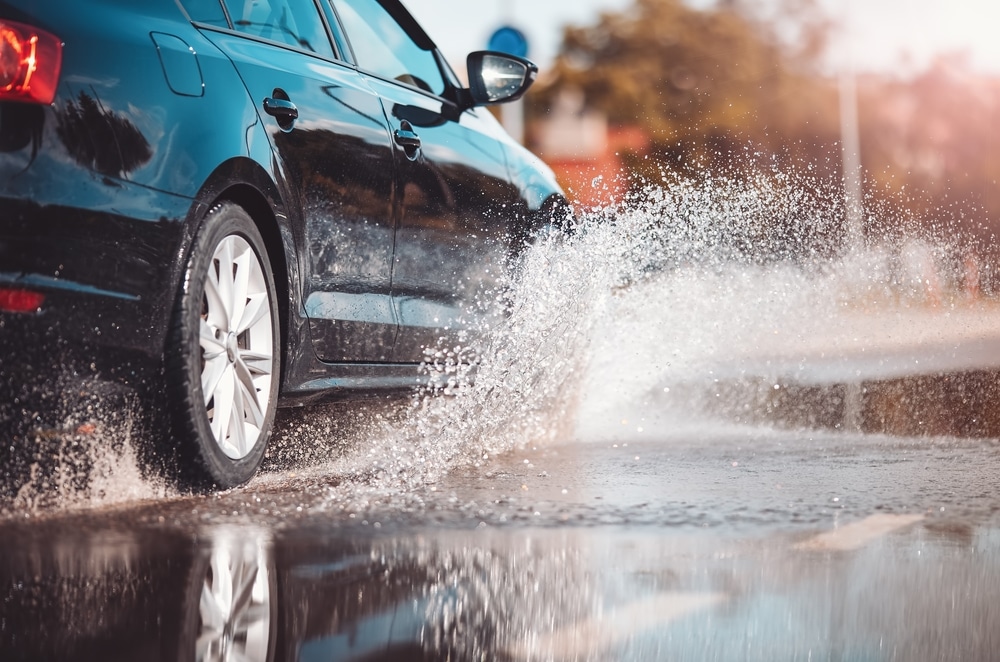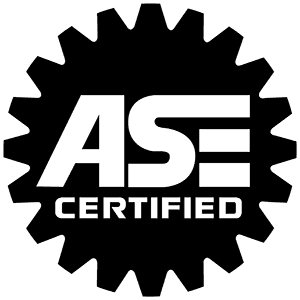Rainy roads can turn a routine drive into a nerve-wracking experience. Wet pavement reduces traction, obscures visibility, and increases stopping distances. The good news? A well-maintained vehicle is your best defense. Before the storm clouds roll in, let’s talk about how to keep your car storm-ready and your drive safe.
The Critical Role of Vehicle Maintenance in Storm Preparedness
A car in top shape gives you better control when the roads get slick. Worn tires, weak brakes, and old windshield wipers won’t do you any favors when the rain starts pouring.
Proactive car maintenance, like a tune-up, isn’t just about preventing breakdowns—it’s about avoiding accidents altogether. Staying ahead of repairs means staying ahead of danger. Even something as simple as keeping your headlights clean can make a big difference when visibility drops.
Essential Pre-Storm Vehicle Checks from Your Auto Repair Shop
Tire Health: Tire Tread Depth and Pressure
Your tires are the only point of contact between your car and the road, so they need to be in prime condition. Balding tires increase the risk of hydroplaning, making it harder to maintain control. Use the penny test to check your tire tread depth at home—insert a penny into the tread with Lincoln’s head down. If you can see the top of his head, your tread is too low, and it’s time for new tires.
Proper tire pressure is just as crucial. Under-inflated tires have less grip on the road, making skidding more likely, while over-inflated tires reduce traction and make handling unpredictable. The recommended tire pressure is inside your driver’s door or in the owner’s manual. If unsure, stop by for a tire rotation and balancing service to stabilize your vehicle in wet conditions.
Windshield Wipers and Visibility
If your wipers leave streaks, make that awful screeching sound, or struggle to clear your windshield, they’re overdue for a replacement. Worn-out wipers can smear rain rather than remove it, making it difficult to see. Most drivers forget windshield wiper replacements until they’re in a storm. A good rule of thumb? Swap them out every six months, or sooner if they aren’t working effectively.
Don’t forget to top off your washer fluid, as dirt and grime build up quickly on rainy days. And while you’re at it, test your defroster and defogging system—fogged-up windows can be just as dangerous as heavy rain. If your defroster takes too long to clear your windshield, we can fix that before the next storm hits.
Brake System Integrity
Brakes take a beating in wet conditions. Water reduces friction, making it harder to stop in time. If your brake pads are worn down, it will take longer to come to a full stop, increasing the risk of skidding or rear-ending someone. You’ll know your brakes need attention if you hear squeaking or grinding noises, feel vibrations when braking, or notice a soft brake pedal.
Brake fluid also plays a crucial role in keeping your brakes responsive. Over time, moisture can seep into the brake fluid, reducing its effectiveness. If your brake pedal feels spongy or less responsive than usual, it’s time to have the system inspected. Our brake repair and maintenance services will ensure your car stops when you need it to.
Lighting and Electrical Systems
Stormy weather cuts visibility for you and everyone else on the road. Functional headlights, taillights, and signal lights aren’t just for your safety—they help other drivers see you, too. Before a storm, check that all your lights are working properly. If your headlights seem dim, it might be time to replace the bulbs or clean the lenses.
A weak battery can leave you stranded in the worst conditions. If your car struggles to start, the dashboard lights flicker, or the battery is more than three years old, it’s a good idea to have it tested. Don’t wait until you’re stuck in the rain—let’s check your battery before the storms roll in.
Oil Change Service and Fluid Checks
Your engine works harder in extreme conditions, and clean oil helps it run smoothly. Old, dirty oil thickens in cold weather and fails to lubricate properly, while fresh oil keeps everything running efficiently.
Other fluids matter too—power steering, transmission, coolant—all play a role in safe driving. Low coolant can cause your engine to overheat, even in the rain. Transmission fluid ensures smooth shifting, which is essential when roads are slick. Regular fluid checks keep your car running at its best. Schedule an oil change with us, and we’ll top off all your essential fluids to keep your vehicle in top condition.
Car Tune-Up and Overall Vehicle Inspection
A well-tuned car runs efficiently and responds better to sudden changes in road conditions. A full vehicle inspection before storm season can catch issues before they turn into problems. Whether it’s worn spark plugs, a sluggish battery, or misaligned wheels, taking care of these details now saves you from headaches later. If you’re searching for “car maintenance near me,” we’re your go-to shop for keeping your vehicle in peak condition.
Driving Tips During a Storm: Auto Repair Insights
Even with a well-maintained car, wet roads require extra caution. Reduce your speed and keep a safe distance from other vehicles—stopping distances increase on slippery roads. If you start to hydroplane, don’t panic. Ease off the gas, keep your steering steady, and avoid sudden movements. Keep your headlights on, but skip the high beams—they reflect off rain and reduce visibility. And if you come across standing water, don’t risk it. You never know how deep it is until it’s too late.
Post-Storm Vehicle Inspection and Maintenance
Once the storm clears, check your car for any signs of water damage. Moisture can sneak into places it shouldn’t, causing rust, electrical issues, or brake malfunctions. Inspect your tires for new wear, and test your brakes—if they feel off, get them checked immediately. A post-storm inspection can catch problems early before they become costly repairs.
Frequently Asked Questions About Driving in Rainy and Stormy Conditions
- What car maintenance is crucial for rainy driving? Tires, brakes, wipers, lights, and fluid levels should all be checked before storm season.
- How does tire tread depth affect driving in the rain? Shallow tread increases the risk of hydroplaning and reduces overall traction.
- How often should windshield wipers be replaced? Every six months to a year, or sooner if they leave streaks or make noise.
- What are the signs of brake issues in wet conditions? Squeaking, grinding, a soft pedal, or longer stopping distances all indicate potential problems.
Stay Safe on the Road All Year With Kwik Kar
Rainy roads don’t have to be risky roads. A well-maintained vehicle makes all the difference in keeping you safe behind the wheel. Don’t wait until the first storm to get prepared—schedule your pre-storm vehicle inspection with Kwik Kar today. Our auto repair shop near you is here to help, and we’re offering special discounts to keep your car road-ready. Book your appointment now and drive with confidence, no matter the weather.




